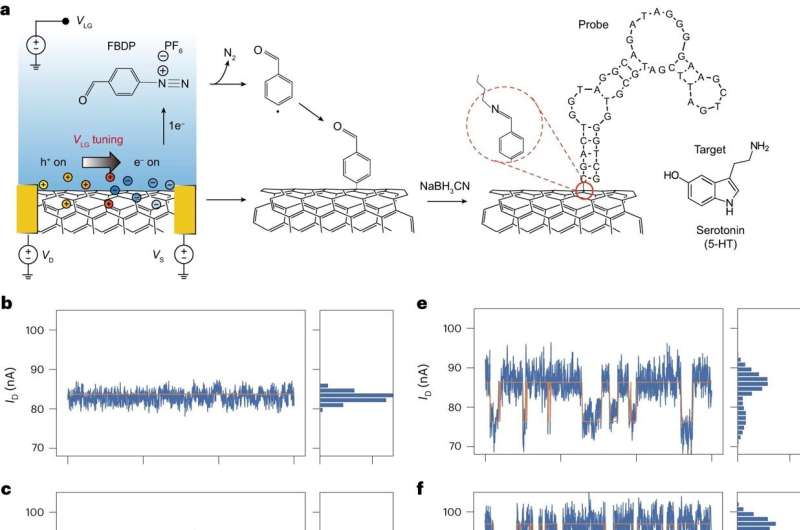Device schematic and concentration-dependent current traces. a, Schematics of the single aptamer immobilization onto the CNT and VLG-controlled diazonium chemistry. A common VLG is applied via a reference electrode in the buffer solution. A single functionalization site on the CNT is generated by sp3 addition controlled by VLG-driven aryl radical generation from a diazonium salt (FBDP). The amine group of a functionalized DNA aptamer is covalently attached to the site by a Schiff base reaction. b, Representative baseline ID–t trace of Device A after aptamer probe attachment in phosphate-buffered saline (pH 7.0). The VLG was fixed at 200 mV, and a VDS of 25 mV was applied. c–f, Representative ID–t traces of Device A at different serotonin concentrations: 0.5 nM (c), 5 nM (d), 50 nM (e), 500 nM (f). The raw ID–t traces (blue line) are overlaid with the idealized fit, revealing two conductance states (orange line). The histograms of ID distributions are shown in the right panels. g, Concentration dependence for the fraction of time spent in the lower conductance state (Plow). The plots of Plow against serotonin concentrations are fitted to the Langmuir isotherm function. Data points are the mean probability of the low conductance state calculated from all dwell times by bootstrapping (Nboot = 2,000). Error bars represent the 90% confidence interval from the bootstrapped mean value of Plow. Credit: Nature Nanotechnology (2024). DOI: 10.1038/s41565-023-01591-0
Researchers have developed a carbon nanotube (CNT) transistor for molecule glasses that facilitates detailed examination of molecular interactions. This innovative technology is poised to open a fresh research direction in nanotechnology and molecular biology.
Tiny particles such as finely charged serotonin and dopamine play significant roles within our bodies. Understanding their movements and interactions is crucial, but there have been constraints in capturing their subtle interactions––until now.
Using a CNT, Dr. Lee Yoon-hee, a senior researcher at the Division of Biotechnology within the Convergence Research Institute, developed a molecular research transistor, or molecule glasses, with unprecedented sensitivity and resolution. Being minuscule, the CNT has high conductivity and is both strong and flexible. Observing molecules with a CNT will allow for the examination of neurotransmitters such as serotonin and dopamine, which possess subtle electrical charges. Interactions with their bonding counterparts will also be observable.
Most importantly, Dr. Lee has applied the newly developed technology to capture structural transformation in four states of aptamer interaction with small serotonin and dopamine molecules, successfully revealing the complex and previously unknown interaction between aptamer and ligand.
The research findings are expected to be valuable tools in nanomedical and biomolecular engineering in the future, heralding advancement in the high-precision study of intermolecular interactions.
Dr. Lee stated, "This technology will open a new horizon for understanding interactions at the molecule level more closely. We aim to offer society a precise medical technology capable of controlling biological systems at the molecular level while also reducing the technological barriers and research costs associated with molecular diagnosis of diseases in the future."
The research is published in the journal Nature Nanotechnology.
More information: Yoonhee Lee et al, Carbon-nanotube field-effect transistors for resolving single-molecule aptamer–ligand binding kinetics, Nature Nanotechnology (2024). DOI: 10.1038/s41565-023-01591-0
Journal information: Nature Nanotechnology
Provided by DGIST (Daegu Gyeongbuk Institute of Science and Technology)
























